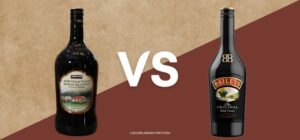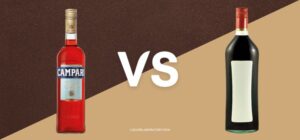Last Updated on November 5, 2023 by Lydia Martin
As someone who enjoys indulging in a good drink, I’ve often found myself pondering the great debate: wine versus tequila. Each has its own distinct flavors and fascinating histories, but which one reigns supreme?
So, whether you’re a fan of the rich and complex flavors of wine or prefer the smooth taste of tequila, there’s no doubt that both have a unique and fascinating history. Join me as I delve into the world of these two beloved beverages and discover what sets them apart.
Table of Contents
ToggleWine versus Tequila: Which is Better?

The Raw Materials
Wine
The raw material used to make wine is primarily grapes. However, other fruits like berries can also be used in certain types of wine. The type of grape used for winemaking depends on the wine intended to be produced.
There are thousands of grape varieties used for winemaking around the world. Still, some of the most common ones include the following:
- Chardonnay: a white grape variety used to make dry, full-bodied white wines.
- Cabernet Sauvignon: a red grape variety used to make full-bodied, tannic red wines.
- Merlot: a red grape variety used to make medium to full-bodied, fruit-forward red wines.
- Pinot Noir: a red grape variety used to make light to medium-bodied red wines with delicate flavors and aromas.
- Sauvignon Blanc: a white grape variety that produces crisp, refreshing white wines with high acidity.
- Riesling: a white grape variety used to make aromatic white wines with varying sweetness levels.
Tequila
The raw material used to make tequila is the blue agave nectar, which is native to Mexico, thus the term “blue agave tequila.” The plant is a type of succulent that grows in hot and arid regions, primarily in the state of Jalisco.
In order for tequila to be considered a protected designation of origin (PDO) product by the Mexican government, it must be made from 100% blue agave. However, some lower-quality tequilas may use other types of agave or even other sweeteners to supplement the agave content.
The Manufacturing Process

Wine
Wine is made through a multi-step process that typically involves the following stages:

- Harvesting: Grapes are harvested from vineyards, usually in the fall. The timing of the harvest depends on the ripeness level of the grapes, which can impact the final flavor and aroma of the wine.
- Crushing and Pressing: The harvested grapes are sorted and then crushed to extract the juice. In some cases, the sap may also be pressed to extract additional liquid. The resulting fluid is called “must.”
- Fermentation: Yeast is added to the must to begin the fermentation process, where the natural sugars in the juice are converted into alcohol. This process can take anywhere from a few days to a few weeks, depending on the type of wine being made.
- Aging: Some wines are aged in oak barrels or stainless steel tanks for some time to enhance their flavors and aromas. The length of time and type of vessel used for aging can vary depending on the winemaker’s preference.
- Bottling: Once the wine has been aged to the desired level, it is bottled and labeled for sale.
Tequila

Tequila is made through the following process:
- Harvesting: The agave plant is harvested when it is mature, which typically takes around 8 to 12 years. The leaves are removed, leaving the piña, the core of the plant, which is then transported to the distillery.
- Cooking: The piñas are cooked in ovens or autoclaves to soften them and convert the complex carbohydrates in the plant into simple sugars.
- Crushing and extracting: The cooked piñas are crushed to extract their juice, which is then fermented with yeast to produce alcohol.
- Distillation: The fermented juice is then distilled to create tequila. Most tequila is distilled twice, although some premium tequilas may be distilled more than this.
- Aging (optional): Some tequilas are aged in oak barrels to enhance their flavors and aromas. The aging process can last anywhere from a few months to several years.
- Bottling: Once the tequila has been distilled and aged (if applicable), it is bottled and labeled for sale.
The Alcohol Content
The wine typically has an alcohol content ranging from 8% to 15% by volume. However, some wines can have an alcohol content as high as 20% or more. In contrast, tequila has a higher alcohol content, typically ranging from 35% to 55% by volume, depending on the type of tequila.
Blanco or silver tequila, which is unaged, generally has a higher alcohol content than aged tequilas such as reposado or añejo.
The Taste Reveal
What is the best way to drink wine and tequila?

Wine is typically served in a stemmed glass to allow the aromas and flavors to develop. Red wine is often served at room temperature or slightly below, while white wine is typically served chilled. Wine can be enjoyed on its own or paired with food. Luckily, many pairing guidelines are available to help you choose the best wine for a particular dish.
Tequila is traditionally served in a shot glass or a narrow, tall glass called a Caballito. Depending on personal preference, it can be served straight, at room temperature, or chilled. Some people prefer to drink tequila with salt and lime, which is done by licking the salt, taking a shot of tequila, and biting into the lime.
Others prefer to sip tequila slowly and enjoy its complex flavors on their own. Tequila is also commonly used in cocktails such as Margaritas or Palomas.
How do wine and tequila taste?

Wine has a wide range of flavors, depending on the grape variety, the region where it was produced, and the aging process. Wine can range from sweet to dry and have strokes of fruits, spices, oak, and more. Some of the most common flavors found in wine include cherry, plum, blackberry, vanilla, and tobacco.
Tequila, on the other hand, has a bold, earthy flavor with notes of agave, herbs, and spice. The taste of tequila can vary depending on the type and quality of the tequila, as well as the aging process.
Blanco or silver tequila, which is unaged, has a sharp, clean flavor with notes of pepper and citrus. In contrast, aged tequilas like reposado or añejo can have more complex flavors with caramel, vanilla, and oak notes.
Because of these claims, I purchased a bottle of wine and tequila to help me verify whether these assertions were factual or mythical. Upon opening both bottles, I noticed that the wine had an aroma ranging from fruity to earthy. Meanwhile, tequila has a distinct vegetal or earthy scent with hints of citrus and spice.
After one shot of both beverages, wine provided various flavors to my taste buds, from sweet to dry and light-bodied to full-bodied. In contrast, tequila has a more distinct and recognizable spicy taste.
The Health Benefits
Wine
- May promote heart health: Some studies have found that moderate wine consumption may help to improve heart health by increasing HDL (good) cholesterol and reducing inflammation [1].
- Contains antioxidants: Wine contains polyphenols, which can help protect the body from oxidative stress and inflammation.
- May reduce risk of certain cancers: Some studies have suggested that moderate wine consumption may help to reduce the risk of certain cancers, such as colon, breast, and prostate cancer.
- Can promote relaxation: Drinking wine in moderation can help reduce stress, promoting relaxation.
Tequila
- May aid digestion: Tequila contains compounds called agave fructans, a type of natural sugar that promotes the growth of healthy gut bacteria, stimulating the digestive system and reducing constipation [2].
- Low in calories: Compared to other distilled spirits, tequila has fewer calories, around 60 calories per 1 oz serving. Thus, drinking agave tequila can lower blood sugar, aiding in healthy weight loss.
- Can promote relaxation: Like wine, drinking tequila in moderation can help promote relaxation and reduce stress.
- Gluten-free: Tequila is made from the agave plant and is naturally gluten-free, thus having fewer calories than most distilled spirits making it an excellent alcoholic beverage option for those with gluten sensitivities.
- Bone health: Drinking tequila may improve your bone health as the agave plant used to craft this spirit contains a compound termed saponins, which have been shown to boost bone density. In turn, reduces the risk of osteoporosis.
FAQs
Is it better to start with wine or liquor?
It’s generally recommended to start with wine before moving on to liquor, as wine has a lower alcohol content and can be easier for those new to alcohol. Wine can also be enjoyed with food and has a wide range of flavors and varieties, making it a good starting point for those who want to explore the world of alcoholic beverages.
However, it’s important to always drink tequila or wine in moderation and to listen to your body when consuming alcohol.
Is tequila healthier than wine?
It’s difficult to say whether tequila is healthier than wine, as both have their own unique health benefits and potential drawbacks. Wine contains antioxidants and polyphenols, which may offer protection against certain diseases and have cardiovascular benefits when consumed in moderation.
On the other hand, tequila is made from the blue agave plant and contains a natural sugar called agavin, which has been shown to potentially lower blood sugar levels and aid in weight loss.
Which is more fattening, wine or tequila?
Both wine and tequila have a similar calorie count, with around 120-130 calories per 1.5 oz serving of tequila and 125-150 calories per 5 oz serving of wine. The calorie count can vary depending on the specific brand and type of wine or tequila.
However, it is revealed that when it comes to hard liquor, tequila has fewer empty calories, zero sugar, and zero carbohydrates, making it a healthier choice. Research suggests that the main factor contributing to weight gain from alcohol consumption is the excess calories consumed rather than the specific type of alcohol.
It’s important to drink alcohol in moderation and to consider the overall calorie content of your beverage, as well as your diet and lifestyle habits.
References
- https://www.webmd.com/diet/features/health-benefits-wine
- https://www.medicalnewstoday.com/articles/health-benefits-of-tequila#agave-health-benefits
















